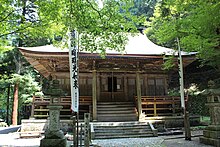Yokokura-ji
The Yokokura-ji ( Japanese 横 蔵 寺 , extensively with the mountain name Ryōkaisan Yokokura-ji ( 両 界山 横 蔵 寺 )) is a temple of the Tendai direction of Buddhism in the mountains on the outskirts of Ibigawa in Gifu Prefecture . Because of its numerous treasures, it is also called the " Shōsō-in of West Mino ".
history
According to tradition, priest Saicho built the temple in 805. Saichō is said to have carved two Yakushi Buddha from a log of a consecration column , one of which he gave to Enryaku-ji and the other to this temple as the main cult figure. After the destruction of the Enryku-ji by Oda Nobunaga , the one lost there is said to have been replaced by the Yakushi of this temple. The yokokura-ji is said to have received a yakushi from the north of Kyoto. - The name of the temple, literally “secondary storage temple”, is said to come from the fact that Saichō first set up a small gold-plated yakushi that he had brought from China, “stored next door” to the large one made of wood.
In the 10th century there was a connection with the seven shrines of Hiyoshi Sannō ( 日 吉 山 王 ), in the Kamakura period there were 38 Klausen, the temple flourished. Fires and typhoons ravaged the temple during the Muromachi period until it recovered in the Edo period .
The attachment
The first temple complex was located away from the valley near the mountain peaks, as can be seen from the preserved pillar foundations and on their side. Later the temple was moved further down until it was in its current location after 1646. If you go from the street over the small, red-painted bridge, you come immediately right up the stairs to the temple gate. This is designed as a two-story gate ( 楼門 , Rōmon ), which is supported on four by four posts . Its roof is designed as a stepped hip roof ( 入 母 屋 造 , Irimoya-zukuri ). To the right and left of the passage are the statues of the temple guards ( 仁王 , Niō ).
After passing the gate, the three-story pagoda ( 三重 塔 , Sanjū-no-tō ), built in 1663, is on the right . The main hall ( 本 堂 , Hondō ) from 1671, which has a detached hip roof, follows ahead . The hall is five ken (5 × 1.81 m) wide, as corresponds to most of the main halls of temples of the esoteric direction of Buddhism. All three buildings are covered with cypress bark shingles and are registered as a cultural asset of the prefecture.
Behind the main hall there are two smaller buildings, the reliquary hall ( 舎 利 同 , Shari-dō ) and the Yuri-hall ( 瑠 璃 堂 , Yuri-dō ); both are open to the public. The priest Myōshin-hōshi ( 妙 心 法師 ), who came from this area, has been kept and venerated as a mummy in the reliquary hall since 1817 .
Treasures of the temple
In the Yuri hall stands the heavenly general Jinsha ( 深 沙 大将 , Jinsha daishō ). It comes from the Heian period and is carved from one piece of wood. With his big eyes and his mouth open to the side, he makes a foreign impression, he could come from Korea. In the three-story pagoda there is a seated Dainichi Buddha made of wood, which, according to the inscription, dates from 1183. There is also a Yakushi Buddha, which could have been made by a sculptor of the Kei direction in the Kamakura period . The Twelve Heavenly Generals date from the end of the Heian and the beginning of the Kamakura period . The temple also has the Four Kings of Heaven and the Guardian Couple ( 金剛 力士 , Congo-rikishi ) from 1256.
The temple also has a Hokke mandala ( 板 彫 法 華 曼荼羅 ) carved in white sandalwood . In the center there is a relief of a treasure pagoda ( 多 宝塔 , Tahōtō ), which contains the Shaka Buddha ( 釈 迦 如 来 , Shaka nyorai ) and two other Buddhas. To the right and left are the saints Monju ( 文殊 ) - and Fugen-bosatsu ( 普賢 菩薩 ) as well as the Four Kings of Heaven.
All mentioned figures and the mandala are registered as an important cultural asset of Japan .
Remarks
literature
- Gifu-ken kotogakko kyoiku kenkyukai komin-chireki-bukai, chiri-bukai (Ed.): Yokokura-ji . In: Gifu-ken no rekishi sampo. Yamakawa Shuppan, 2006. ISBN 978-4-634-24621-8 . Pp. 127-128.
Web links
Coordinates: 35 ° 33 ′ 11.6 ″ N , 136 ° 33 ′ 40.4 ″ E


